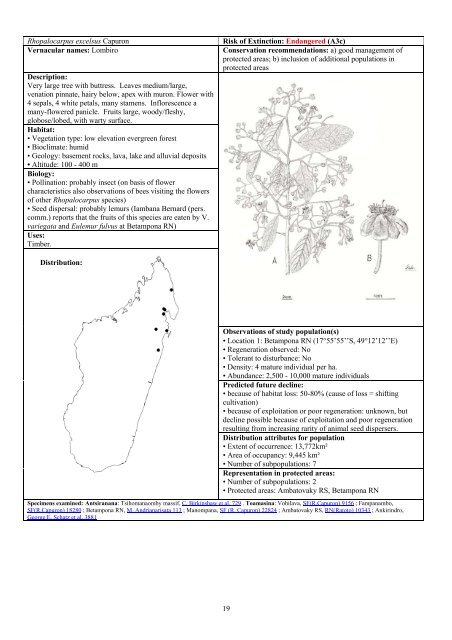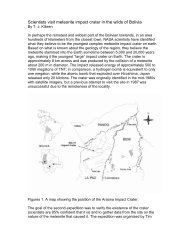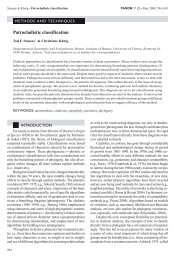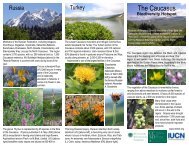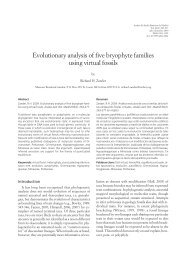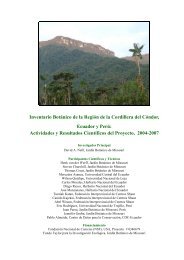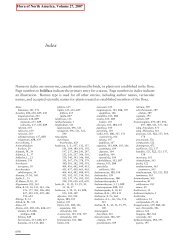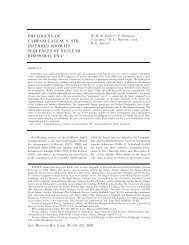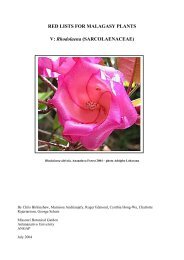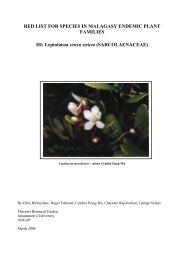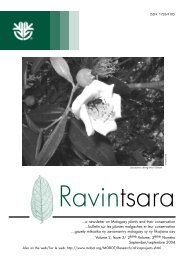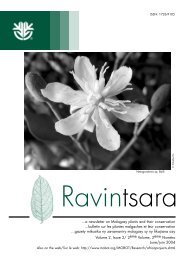red lists for malagasy plants iv: sphaerosepalaceae - Missouri ...
red lists for malagasy plants iv: sphaerosepalaceae - Missouri ...
red lists for malagasy plants iv: sphaerosepalaceae - Missouri ...
Create successful ePaper yourself
Turn your PDF publications into a flip-book with our unique Google optimized e-Paper software.
Rhopalocarpus excelsus Capuron Risk of Extinction: Endange<strong>red</strong> (A3c)<br />
Vernacular names: Lombiro Conservation recommendations: a) good management of<br />
protected areas; b) inclusion of additional populations in<br />
protected areas<br />
Description:<br />
Very large tree with buttress. Leaves medium/large,<br />
venation pinnate, hairy below, apex with muron. Flower with<br />
4 sepals, 4 white petals, many stamens. Inflorescence a<br />
many-flowe<strong>red</strong> panicle. Fruits large, woody/fleshy,<br />
globose/lobed, with warty surface.<br />
Habitat:<br />
• Vegetation type: low elevation evergreen <strong>for</strong>est<br />
• Bioclimate: humid<br />
• Geology: basement rocks, lava, lake and alluvial deposits<br />
• Altitude: 100 - 400 m<br />
Biology:<br />
• Pollination: probably insect (on basis of flower<br />
characteristics also observations of bees visiting the flowers<br />
of other Rhopalocarpus species)<br />
• Seed dispersal: probably lemurs (Iambana Bernard (pers.<br />
comm.) reports that the fruits of this species are eaten by V.<br />
variegata and Eulemur fulvus at Betampona RN)<br />
Uses:<br />
Timber.<br />
Distribution:<br />
Observations of study population(s)<br />
• Location 1: Betampona RN (17°55’55’’S, 49°12’12’’E)<br />
• Regeneration observed: No<br />
• Tolerant to disturbance: No<br />
• Density: 4 mature ind<strong>iv</strong>idual per ha.<br />
• Abundance: 2,500 - 10,000 mature ind<strong>iv</strong>iduals<br />
P<strong>red</strong>icted future decline:<br />
• because of habitat loss: 50-80% (cause of loss = shifting<br />
cult<strong>iv</strong>ation)<br />
• because of exploitation or poor regeneration: unknown, but<br />
decline possible because of exploitation and poor regeneration<br />
resulting from increasing rarity of animal seed dispersers.<br />
Distribution attributes <strong>for</strong> population<br />
• Extent of occurrence: 13,772km²<br />
• Area of occupancy: 9,445 km²<br />
• Number of subpopulations: 7<br />
Representation in protected areas:<br />
• Number of subpopulations: 2<br />
• Protected areas: Ambatovaky RS, Betampona RN<br />
Specimens examined: Antsiranana: Tsihomanaomby massif, C. Birkinshaw et al. 729 . Toamasina: Vohilava, SF(R.Capuron) 9156 ; Fampanambo,<br />
SF(R.Capuron) 18280 ; Betampona RN, M. Andrianarisata 113 ; Manompana, SF (R. Capuron) 22824 ; Ambatovaky RS, RN(Ratoto) 10343 ; Ankirindro,<br />
George E. Schatz et al. 3881<br />
19


